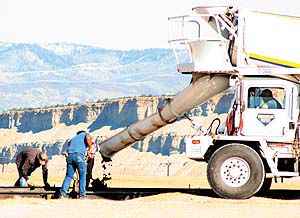| Workers at the Carbon County Fairgrounds lay concrete for a new parking area. Nonresidential construction such as this has taken up the slack in the downward trend of residential starts. |
Utah’s number of nonfarm wage and salaried jobs for April grew by 4.5 percent over the past year. Employment growth has held steady at this level throughout 2007.
Utah’s current growth remains well above the state’s long-term average of 3.3 percent per year since 1950. Approximately 54,000 new jobs have been created in the Utah economy over the past year, raising total wage and salary employment in Utah to 1,247,800. This increase translates to around 4,500 new jobs created monthly in Utah over the past year.
Utah’s other primary indicator of current labor market conditions, the seasonally adjusted unemployment rate, measures 2.5 percent for April, down 0.6 percentage points from the unemployment rate of 3.1 percent registered a year ago in April, 2006. Approximately 33,700 Utahns were unemployed in April 2007 as compared to 40,000 in April 2006. The United States’ unemployment rate registered 4.5 percent in April.
“Utah is riding a sustained period of employment growth,” said Mark Knold, chief economist for the Department of Workforce Services. “It began in late 2003 and is rolling on into its fourth year. During that time we became one of the better performing state economies in the nation, but generally trailed Nevada and Arizona for top billing. But from what I can ascertain now looking at recent Bureau of Labor Statistics data measuring all the states, we are now the best-performing state economy in the nation. Nevada and Arizona have slowed just enough to allow Utah to move ahead. Our neighbors are still doing well, Wyoming, Idaho, Arizona, and Nevada, but right now, we stand at the top.”
Since April 2006, the United States’ economy has added 1.9 million new jobs, a growth rate of 1.4 percent. The approximately 54,000 new jobs in Utah represent about 2.8 percent of all the new jobs added in the U.S. over the past year, this from a state that comprises less than one percent of all U.S.jobs.
There is current irony in the relationship between the Utah economy and the greater U.S. economy. Intuition would imply that Utah would benefit from a stronger U.S. economy, the thinking being that a rising sea lifts all ships. But currently Utah is actually in a better position from a weaker U.S. economy than if the country as a whole would find more solid footing and grow at a faster pace, employing more workers. With an unemployment rate as low as ours, Utah needs the excess labor that other parts of the U.S. provides. That excess labor pool would dry up if the countrys economy became stronger and workers from other parts of the country decided to stay put and find jobs where they are.
That very situation actually happened to Utah in the late 1990s. As the U.S. economy strengthened, Utah’s weakened. The state lost our labor inflow, and Utah’s then strong employment growth lost its fuel. As it stands now, pockets of weakness throughout the U.S. seem to be sufficient to supply Utah with the additional labor that it needs. This domestic inflow is especially beneficial to the higher-paying, knowledge-based jobs that Utah is producing and that an economy needs to enhance its earnings and wealth. International labor flows, though potentially controversial to mention, are providing Utah with a supply of lesser-skilled labor that might otherwise be an area of labor shortfall in a hyper-low unemployment environment like Utah’s.
Employment growth remains strong in all sectors, with the exception of the information sector, which actually recorded a small employment loss over the past year. This is the first month in several years where we are actually seeing a year-over job loss in an industrial sector. But even that area’s loss is tempered, as it is really more of an accounting loss than an actual job loss. For instance, America Online (AOL) in Ogden closed, but Teleperformance absorbed most of its workers. In reality, little if any jobs were lost in Utah because of this. Yet on paper, those jobs were lost in the information sector, only to be transferred to the professional and business services sector.
Still, with the information sector going negative with the loss of merely 400 jobs, it does unveil the overall weakness in that sector. It is dominated by the telecommunications industry, and that industry is still struggling to revive itself after the tech-bubble bust earlier in the decade.
Other than this anomaly, all other industries are growing and doing well in Utah. Construction continues as the strongest employment growth area, far outdistancing all other industries. With its three-years-and-counting strong growth pace, construction will once again be Utah’s strongest employment-growth industry this year.
There is a subtle change underway in the fundamentals of the construction industry. Residential construction permit activity began to surge in early 2003, culminating in an historic high in mid-2006. Since then, that peak has passed, and permit authorizations, though still historically high, are noticeably trending downward. But nonresidential activity has stepped in to fill any void. A surge in nonresidential construction usually lags a surge in residential construction by roughly two years. First houses are constructed, then the churches and retail establishments follow. Utah nonresidential construction valuation began its surge in early 2005 and is still in the process of developing and climbing to its peak. This suggests that whatever construction layoffs that the residential building industry may incur because of fewer building permits will be easily absorbed and employed by the surging nonresidential industry. Residential construction is more labor intensive than nonresidential, but with all the commercial and industrial construction underway in Utah, the net effect is continued construction employment growth in Utah through this year and into next.

